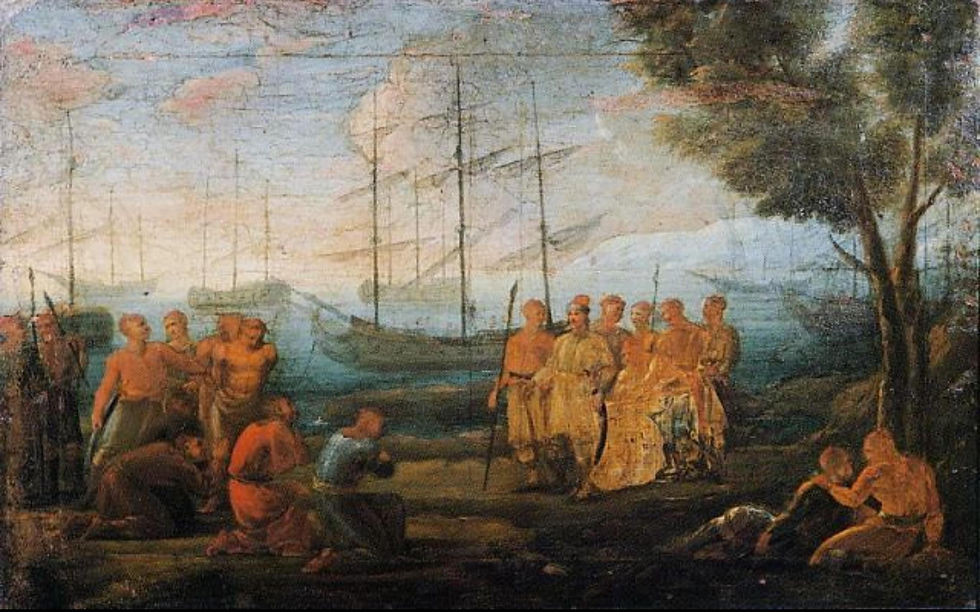D - 25: Lancasters and B-17s over La Spezia
- hbanziger
- Jun 16, 2020
- 4 min read
Updated: Mar 26, 2021
One of the advantages of sailing off the beaten track is getting off the beaten track. With a few exceptions, the places we visit did not see much development – except tourism of course. Not being the backbone of a modern nation states keeps you impoverished - as we’ve seen in the blog on emigration – but also provides protection during wars. The places on our route were strategically unimportant. Liguria, Corsica and Sardinia saw little fighting from 1942 to 1945. Their heritage is largely intact. Something that cannot be said of Italy.
The three exceptions on our route are Bastia, Genoa and La Spezia. Bastia in Corsica saw some fighting in October 1943 when a French-Moroccan Force harassed the retreating 16th German Tank Division. But overall, damage was light. Genoa suffered worse. It was Italy’s main naval base and repeatedly bombed. Damage was substantial and aggravated by the careless reconstruction after the war’s end. The four-lane highway, “Sopraelevata”, built right through the harbor area in 1965, did the rest – it is ugly. La Spezia fared better – even though it was Regia Marina’s (Italian Royal Navy) second base on the west coast. It was bombed between April and June 1943 but then left alone. The damage in La Spezia was limited.

Avro Lancaster Bomber of the Royal Air Force over La Spezia on 13/14 April 1943 – the position of the Battleship Roma is indicated by the arrow - the round dot is a flare
The war in North Africa ended on 9 May 1943 with the capitulation of the German North Africa Corps. 230’000 Germans were taken prisoners. At this point, English and American planners had set their eyes on the invasion of Italy. Amphibious landings on the south coast of Sicily were scheduled for early July 1943, followed by the invasion of mainland Italy.

The campaign in Italy from July 1943 to May 1945 which brought heavy fighting to Italy and destroyed a considerable part of the country’s heritage
To eliminate the threat of the Regia Marina - still a considerable naval fighting force then - the Strategic Bomber Command decided to sink Italy’s capital ship. Three of them, the Roma, the Vittorio Veneto and the Littorio were anchored in La Spezia. Bombing raids started with a RAF attack on 13/14 April 1943 (see first picture). The night raid was less successful than expected thus followed up five days later. Hitting ships from high altitude at night was difficult though. The US Air Force thus launched a day-time attack from North Africa on the 5 June with 117 B-17 Bombers. This time, it succeeded. The hulls of both the Roma and the Vittorio Veneto were heavily damaged. Only the Littorio remained operational. The threat of Italian battleships to the invasion of Sicily was eliminated. First Roma, then Vittorio Veneto, had to sail to Genoa for repairs.

USSAF attack on 5 June 1943 – the Italian Battleships are visible amidst the water fountains
In May 1943, the wharfs of Genoa were still mostly out of reach of US and British bombers thus the repairs proceeded quickly By 20 June, Roma was back. Another attack became necessary. The Allied Commanders learned from their decrypting units that Italy indeed planned to use all its naval forces to oppose a landing in Sicily. The Royal Air Force developed a new concept: Shuttle Bombing.

First Shuttle Bombing Raid in History – on 23 June 1943
It enabled it to bomb at last light and then use the safety of the night to return to base. On the first leg the RAF attacked the radar manufacturing plant in Friedrichshafen on the Lake of Constance. On the way back from Tunisia, the target was La Spezia. The raid succeeded. Roma and Littorio were missed but the fuel tanks in the harbor and a German oiler blew up. The fuel for long-range operations burnt off. But a part of La Spezia’s downtown was hit.

Bombing damage in downtown La Spezia in 1943
The further course of the war then saved La Spezia from more harm. On 3 September 1943, Italy capitulated. The Regia Marina units from the Adriatic and Taranto surrendered in Malta. The flotilla from La Spezia grouped around the battleships Roma and Littorio set out for Sardinia to join the Royal Navy. They were found however by German bombers. The Roma was sunk with all hands, including the Commanding Admiral Bergamini. It is one of these ironies in history – losing your life when the war was over. In total, 5 battleships, 33 destroyers and 39 submarines surrendered to the Allied Forces and fought for the rest of the war with Royal and US Navy.

La Spezia and its harbors today where we are going to sail
When we enjoy the beauty of La Spezia today, we have to be grateful to the British and American pilots who refrained from carpet bombing and focused on the battleships. And of course the brave Italians who had the courage to end the war. It was eventually the surrender of the Italian fleet that protected La Spezia.







Comments